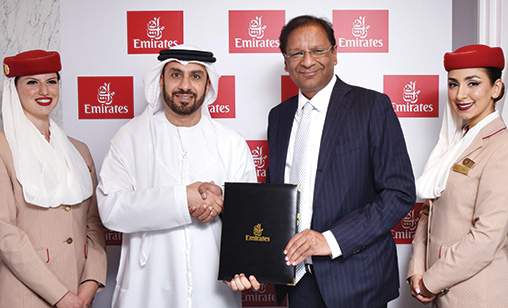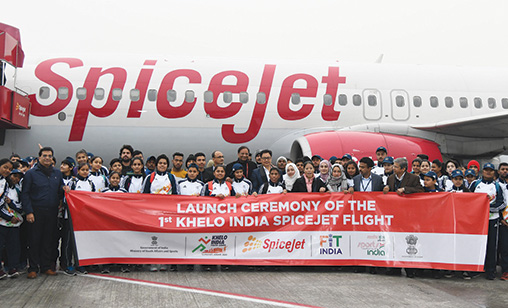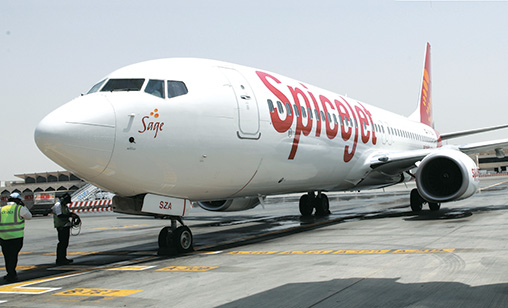Cover Story
SpiceJet’s go-getter boss
Chairman and managing director, Ajay Singh, is setting a scorching pace of expansion at the Indian low-cost carrier.
February 1st 2020
In March 2019, a month before the collapse of Jet Airways and in the midst of the frenzy of the country’s general election, a high level meeting of government ministers and officials was held in New Delhi. Read More » It was evident to those in charge that little could be done to keep full-service Jet flying. The meeting was to examine ways to minimize the damage caused by the failing carrier and ensure fares did not shoot up in the middle of the election season.
Pressure from the industry also was building on the government to take a call on Jet’s slots. Several were at the massively constrained Mumbai airport and were not being utilized as Jet’s problems had steadily mounted from August 2017.
 |
It was decided the slots would be offered to other airlines and preference would be given to carriers that could bring in additional capacity the quickest.
All the airlines jumped in as slots at Mumbai were invaluable and were not available for love or money. At least two airlines, LCC SpiceJet and full-service Vistara, decided to deviate from business as usual and take a big gamble, turning a blind eye to the possible downside of their decision.
SpiceJet, which flies an all-Boeing fleet, was best positioned to take full advantage of the situation. It took 33 of Jet’s aircraft, which were fitted with a two-class configuration. It also received many new slots out of Mumbai. Before Jet’s grounding, SpiceJet had 32 departures a day from Mumbai. This increased to more than 80.
In some ways, the timing for taking on Jet’s aircraft was ideal for SpiceJet as it had suffered a blow from the grounding in March last year of the 13 MAXs it had in operation.
It also meant there would be a delay in replacing its older planes and reduced new capacity planned for last year and in 2020. The double whammy could hit the airline’s revenues through no fault of its own.
If the grounding of the MAX was not enough to manage for Boeing customers, another factor had gripped the Indian aviation sector even as it dealt with the exit of Jet Airways.
Traffic growth had been in double digits since the beginning of the decade but it had hit an unexpected speed breaker. As the overall slowdown of the economy revealed itself, air traffic - like car sales - virtually stopped expanding.
Until November 2019, domestic passengers grew by 3.86 per cent, with the first half of the year recording hardly any rise. Demand is improving for the second half of the financial year, from April 2019 to March 2020, but it is forecast traffic growth for the year will remain in single digits for the first time in a decade.
It is yet to be revealed whether the gambit taken by SpiceJet’s chairman and managing director, Ajay Singh, 54, post Jet’s demise was a calculated or a reckless risk.
In its first quarter, SpiceJet had performed well. The LCC, like almost all the other airlines in India had reported a profit. In the second quarter, capacity rose by 51 per cent over the same month a year ago. Revenue was up, aircraft were full and yields and even fares went up.
 |
But two unanticipated developments ensured the airline reported a deeper than expected loss that led to a sharp fall in the value of the carrier. The Jet aircraft SpiceJet had acquired were in far worse shape than expected.
Sources at SpiceJet said in some cases substandard parts had been used on the aircraft and many records of maintenance and checks were missing or not accessible to SpiceJet.
The Jet airplanes were ageing and fuel burn was correspondingly high. As a result, costs, including maintenance, shot up. The airline’s CASK (Cost per Available Seat Kilometre) in US cents went up to 5.96 against rival, IndiGo’s 5.12, CAPA data reported.
In addition, the eight Jet planes taken on by SpiceJet, over and above the 33 B737NGs, were MAXs, Four of them were grounded and four were stuck after deliveries from Boeing were put on hold.
SpiceJet also hired close to 1900 Jet workers, a decision that proved to be a mixed bag. Although Jet staff were better trained and more professional than most airline employees in India, cultural differences surfaced on occasion and it took some time for people to adjust to their new working environment.
Close to 150 of the new hires either resigned or were asked to leave SpiceJet because they did not fit with the culture of their new owner.
Perhaps the biggest issue for Singh and his LCC to navigate was that Jet’s aircraft were fitted with business class.
As an LCC, SpiceJet operated an all-economy class fleet. Although fares rose slightly during the period of integration of the two fleets, yields did not rise commensurately, reflecting a failure on SpiceJet’s part to charge a premium for its business class offering.
In the next six months, the LCC plans to phase out its Jet aircraft as MAX planes begin arriving at the airline now expected after June.
An MBA from Cornell University in the U.S. Singh has maintained he would do it all again “if the same opportunity was to represent itself, I’d grab it”, when asked about adding Jet planes to his fleet.
A second concern for SpiceJet has been safety. In 2019, the airline had many small incidents and one “accident”, spooking passengers. The airline said it had beefed up its safety oversight and removed underperforming employees.
But in a country where commercial considerations often outweigh safety concerns, SpiceJet’s assurances have not convinced everyone. Many passengers only fly SpiceJet if they have no alternative.
The airline’s customers also complain the LCC’s airplanes have a tired feel. SpiceJet said it was aware of the issue and blamed it partly on the age of its fleet. It hoped to improve its product image after re-fleeting commenced, the airline has said.
 |
A FINGER IN MANY PIES
Even as he steers his rocky ship through choppy waters, Singh has his fingers in many other pies. Last year, he was elected president of the Founding Board for Better Boxing, set up by the AIBA, a world body for boxing. He also has been president of the Indian Boxing Federation since 2016.
In January 2019, he became the first Indian to chair the Aviation, Travel and Tourism (ATT) Governor’s Meeting at the World Economic Forum in Davos. At home, he chairs the CII National Committee on Civil Aviation and is chairman of the World Travel & Tourism Council, India Initiative (WTTCII). In June, he was voted onto the board of governors of the International Air Transport Association.
More recently, Singh announced plans to launch an international hub operation out of Ras Al Khaima, 40 minutes from Dubai, where he sees “great potential”. His critics argue the project is “unrealistic”.
There are bilateral flying rights available and Ras Al Khaima can be a proxy for Dubai. The plan is to explore the option of introducing some flights to Eastern Europe and the Middle East from Ras Al Khaima. A demand analysis is being done company sources said.
From a SpiceJet perspective, there was no reason to reject investigating the establishment of an offshore base that was close to its Gurugram (formerly Gurgaon) home.
But aviation analyst and former IndiGo chief of operations, Shakti Lumba, said “it may be a good idea, but it does not appear to be thought through as of now”.
Setting up a base for an Indian carrier in foreign territory runs into many regulatory issues and unless they can be managed the project may remain more of a pipedream than a reality, Lumba said.
When the announcement was made, it was claimed four to five aircraft would be operating six to seven hour medium-haul routes by last December, but this is yet to happen.
Singh seems to be homing in on the Middle East. Since November, the airline has committed to an interline agreement and code-share with Emirates Airlines. A Memorandum of Understanding with Gulf Air has been signed.
Industry observers argued Singh should be cautious about starting new businesses because he runs the risk of spreading himself too thinly across seveal enterprises.
A B2B cargo delivery service was launched in 2016 and is running for select corporate clients. In 2017, Singh surprised observers and industry watchers by opening SpiceStyle stores, including one in Gurugram’s Galleria market, one of the more expensive retail centres [in India], to sell designer and other lifestyle products. The Galleria store has closed, but two stores in Hyderabad and Delhi, respectively, are still trading.
 |
In 2018, the airline launched SpiceStar, a training academy for youngsters interested in a career in aviation. Established in partnership with Amity University in Noida, it is a homegrown hiring ground for the airline.
SpiceJet, which earns 17% of its income from ancillary revenue, is aiming to increase that number to 25% and is exploring all avenues to this end. A broadband and Internet-on-board service is planned for the airline’s fleet as soon as deliveries of its ordered airplanes commence.
GOING IT ALONE IN THE COCKPIT
What spooks some observers is the new ventures and strategies are being concluded or explored largely by Singh alone because he operates one of the leanest senior management structures in the industry.
The lack of a second line of command makes them jittery. Less charitable rivals said Singh is “a control freak”, a charge he dismisses with a laugh.
While the airline has tripled in size since 2014, it has hardly added heft at the top. Singh, who holds equity of 59.13% in the airline group, is its highest paid employee, averaging an annual pay package worth 304 times that of a median employee’s remuneration. The only other highly paid SpiceJet executives are the CFO and the company secretary.
No one denies Singh has executed a remarkable turnaround at the LCC after he returned to the carrier he co-founded in 2005 a decade later. Although his critics are reluctant to give him full credit for the achievement. They said he has had government support and a bit of luck, but grudgingly respect his success.
In December 2014, the airline had 32 aircraft and its 5,400 employees were staring at closure of the carrier. Five years later, even if the LLC’s future may not appear to be hunky dory, the airline has 119 aircraft and 15,300 employees with secure jobs.
Present and past staff praise Singh for his temperament and his ability to face crises without losing his composure. As a boss, he’s considered amiable and generally unruffled, characteristics not shared by many others in similar leadership roles in India.
Nonetheless, investors and market analysts remain nervous about Singh’s single man army approach. SpiceJet is a medium-sized airline with almost as many aircraft as Jet had when it collapsed, even if the comparison is not strictly fair.
Jet had a fleet of 116 aircraft when it began to falter. It paid two to three times the rate rivals did for the same job. In many positions, Jet had three people doing work that could have been be tackled by one staffer.
Its senior management was overpaid by industry standards with more than 20 of the airline’s executives drawing very high salaries.
Singh believes “too many cooks spoil the broth” and the fact his senior team and employees maintain a low profile in the industry did not mean they were not contributing or were absent on the job.
“We have grown by 50% in Available Seat Kilometres (ASK) and the airline has added to its employee count in keeping with this growth,” he said.
Management bandwidth will be augmented as and when the need arises. Singh has no intention of adding layers of management for the sake of it. He said many airlines in India have had too many people working on the same task, which has led to executives spending all their time “protecting their turfs”.
The appointment of a new SpiceJet chief commercial officer is on the cards, but at a macro level Singh sees no reason to add “fat cats” and mess with a structure that has worked until now just because others may be uncomfortable with it.
His view is disputed in some industry quarters because the SpiceJet board is largely of his choosing and senior executives are perceived as his “yes men” by critics.
Jet Airways went under with a similar “captive” board that failed to act when the airline was in trouble because of the influence wielded by its co-founder and chairman, Naresh Goyal.
“Unless he fixes this, SpiceJet runs the risks Jet did and a similar fate to Jet cannot be ruled out. This is no longer a mom and pop store,” Lumba said.
The future remains up in the air
Running a low-fare airline almost anywhere in the world can be a bit of a mug’s game. There are many variables to constantly juggle to keep an LCC above water, be it volatile fuel prices, agitating pilots, unhappy passengers, yo-yoing ancillary revenue, currency fluctuations and rivals undercutting you with unsustainable fares.
Despite every efficiency being exploited, there is almost no guarantee an LCC can make money in any given year because so many operating factors are beyond its control.
In India, the situation is worse than in most countries. As well as the usual variables, the costs of operation in India are higher by almost 25% because of higher aviation turbine fuel prices and airport charges.
Additionally, LCCs in India do not operate on a level playing field compared with their non-Indian headquartered rivals. The Indian regulator sets its own parameters for carriers.
For instance, airlines cannot earn ancillary revenue, as is the practice with the unbundling of services globally, from baggage carried. India’s Directorate General Civil Aviation mandates all tickets must include a free 15 kilogram baggage allowance, a regulation low-fare airlines resent.
Looking ahead, SpiceJet is anticipating a hefty compensation payout from Boeing for the MAX grounding and its delayed deliveries of the type. SpiceJet was expecting to receive 28 new aircraft from 2019 to this year at its home hub.
In his negotiations with the U.S. manufacturer, Singh is pushing for a US$500 million settlement. It is speculated the final payout will range from $300 million and Singh’s $500 million target. Recently, Boeing concluded MAX compensation agreements with Turkish Airlines and Southwest Airlines.
The MAX grounding could be converted into a future opportunity for SpiceJet if it sticks with the MAX by pushing for lower acquisition costs for future expansion of its fleet.
Whether the airline will remain with Boeing is a question yet to be answered. Airbus has been aggressively pursuing SpiceJet, which is the only Boeing dominated carrier in India, The LCC also flies Q-400s.
The European manufacturer wants to add another feather in its sales cap by persuading SpiceJet to replace its Boeing fleet with A330s and A321neos. If Airbus succeeds, it will enjoy a monopoly in a country with a population of 1.3 billion.
In the meantime, SpiceJet hopes to control costs that went haywire in the second quarter of the year after the new MAXs were incorporated into its fleet.
A substantial sector of its expansion is based on having the MAXs delivering better performance, fuel efficiency and cabin comfort. In other words, the airline’s future is closely linked to the future of Boeing, its aircraft supplier.
| SpiceJet’s turnaround king Ajay Singh is the principal shareholder of SpiceJet, India’s second largest airline, which he helped start in 2005. He took a break from the carrier in 2010, but returned to lead the carrier as it veered towards closure in 2015. From imminent collapse, the low-cost carrier has become the second biggest airline in India, after another budget carrier, IndiGo. Singh is a first generation entrepreneur who is frequently described as the father of India’s aviation industry. After the LCC recovered from near bankruptcy, Singh ordered 205 aircraft, one of the largest orders for new airplanes in Boeing’s history. Singh followed up his Boeing commitment with the purchase of Bombardier Q400 planes, the single largest order for the Q400 in Bombardier’s history. Singh is a political animal who played an important role in the rise to power of the Modi-led Bharatiya Janata Party. He is credited with conceiving the popular campaign slogan ‘Abki Baar Modi Sarkar - now is the time for a Modi Government’ - in Modi’s first election win in 2014. Before SpiceJet, Singh helped turn around the loss-making Delhi Transport Corporation (DTC) and the national Television Broadcast network, Doordarshan. In the two and a half years Singh spent at the DTC, the corporation experienced a spectacular revival and a run of profits. He also has been an advisor to the Ministry of Telecommunications and Information Technology where he was a leader in drafting the National Telecom Policy and the Information Technology Policy and was influential in modernizing India’s telecom and IT industries. Singh graduated in engineering from the prestigious Indian Institute of Technology, Delhi, holds an MBA from Cornell University in the U.S. and received his law degree from the University of Delhi. |